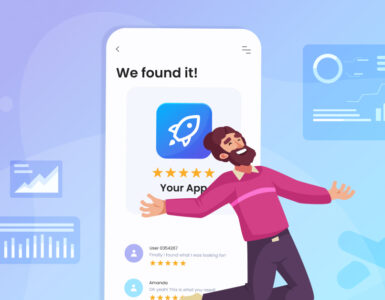The world of washing applications is constantly changing, and each time the question arises: how to effectively increase the number of application installations.
There are two main strategies that dominate this issue: paid and organic app installation.
Each method has its own set of advantages and disadvantages, so choosing between them is a key decision. In this article, we’ll look at the pros and cons of paid and organic app installations, helping you make informed choices for your app’s success.
Paid application installations:
Pros:
- Fast results. Paid installs guarantee quick visibility, ensuring that your app reaches the widest possible audience in the shortest possible time.
- The target audience. Ads can be tailored to specific demographics, ensuring your app is seen by users who are likely to interact with it.
- Scalability. Paid campaigns can be scaled to fit your budget, giving you flexibility in your marketing strategy.
Cons:
- Cost. Advertising campaigns can be expensive, and costs can quickly accumulate, especially for high-demand keywords.
- Short-term Impact. Once you stop investing in paid installations, the influx of new users might dwindle, affecting long-term growth.
- Credibility Concerns. Some users might be skeptical of apps promoted through ads, questioning the app’s authenticity.
To secure paid installations for your mobile application, adhering to several essential rules is crucial. Firstly, meticulously research and select relevant keywords for your app. These keywords should accurately represent your app’s core features, ensuring your ads are displayed to users genuinely interested in your app’s offerings.
Secondly, optimize your app’s listing and creatives to make them visually appealing and informative. High-quality app icons, engaging screenshots, and a compelling description significantly enhance the chances of conversions.
Thirdly, set a realistic budget and bid strategy. Understand the costs involved and bid strategically on keywords to maximize your return on investment. It’s essential to strike a balance between a competitive bid and staying within your budget constraints.
Additionally, constantly monitor and analyze your campaigns’ performance. Regularly review metrics like click-through rates, conversion rates, and cost per acquisition to fine-tune your strategy and improve results over time. Lastly, keep your app content and user experience top-notch. Positive reviews and high user satisfaction contribute to organic growth and can even improve your app’s visibility in the app store, indirectly supporting your paid installation efforts. By following these rules, you can optimize your paid installation campaigns for better results and a higher ROI.You can learn more about attracting installs from paid traffic in our previous article here.
Purchasing Installations through Specialized Services:
In the pursuit of increasing app downloads, developers are increasingly turning to specialized services that offer the option to buy installations. These platforms, commonly known as Install Farms or CPI (Cost Per Install) networks, present a unique approach to app promotion. Let’s explore the pros and cons of utilizing these services for purchasing installations.
Pros:
- Purchasing Installations Using Specific Keywords. These services allow you to acquire installations based on specific keywords, ensuring your app is installed by users who are actively searching for applications related to those keywords.
- Swift Surge in Installations. Utilizing these platforms often results in a rapid influx of installations, propelling your app to the top ranks swiftly and increasing its visibility.
- Quick Access to Top Charts. Purchasing installations can push your app into the coveted top charts, enhancing its discoverability and attracting more organic downloads.
- Performance Monitoring. Specialized services usually provide detailed performance metrics, enabling you to track the effectiveness of your campaigns in real-time. This data is invaluable for making informed marketing decisions.
Cons:
- Risk of App Bans. There’s a risk of app stores banning applications that have artificially inflated installations. However, this can be mitigated by a strategic procurement approach and fostering organic growth alongside paid installations.
- Quality of Users. Acquired users might not always be genuine or active. Some could be bots or individuals motivated to install apps for rewards, resulting in low engagement rates and retention.
It’s essential to note that purchasing installations might not yield immediate financial gains. However, it provides a foothold in the app store’s top charts, increasing your app’s visibility. This heightened visibility, in turn, often leads to a surge in organic installations in the near future. Balancing these advantages and drawbacks is key to a successful app promotion strategy, ensuring sustainable growth and a genuine user base over time.
Organic app installs:
Pros:
- Economical. Organic growth is budget-friendly because it uses word of mouth, recommendations, and positive reviews to attract users.
- Confidence. Users often trust organic search results more than paid advertising, which increases your app’s credibility and reputation.
- Sustainable growth. Organic installs, once acquired, become more stable over time, providing a consistent user base.
Cons:
- Takes a lot of time. Creating organic appeal takes time and effort, as well as a smart marketing strategy and patience.
- Limited initial coverage. It can be difficult for new apps to gain visibility without the support of paid promotions, especially in a competitive market.
- Dependence on app store algorithms. Organic installs are influenced by app store algorithms, so it’s critical to effectively optimize your app listing.
As you can see from the Sensor Tower article, 60% of all installs in the App Store come from search. The situation is approximately the same in Google Play. Since we found out that only organic traffic lives in search, we can conclude that this is the source of organic traffic.
Achieving organic mobile app installs requires a strategic approach and adherence to several key rules.
First and foremost, focus on app store optimization (ASO). This involves researching and incorporating relevant keywords into your app’s title and description, making it easier for users to discover your app through organic searches.
Secondly, cultivate a strong online presence and engage with your target audience through social media platforms and relevant online communities. Positive reviews, social media shares, and word-of-mouth recommendations can significantly boost your app’s credibility and visibility. Encourage satisfied users to leave reviews and ratings, as these play a pivotal role in influencing potential downloaders.
Thirdly, regularly update your app to enhance user experience and add new features. Apps that are frequently updated tend to rank higher in app store search results, making them more visible to users. Additionally, create compelling and shareable content related to your app, such as blog posts, videos, or infographics, to generate buzz and attract organic traffic.
Lastly, analyze user behavior and feedback, using this data to continually refine your app, ensuring it meets user needs and expectations. By adhering to these rules, you can foster organic growth, building a loyal user base and increasing your app’s visibility without the need for costly advertising campaigns.We previously wrote an article on the topic of how to increase organic traffic installations, you can read it here.
Conclusion: Striking the Right Balance for App Success
In the dynamic world of app installations, the choice between organic growth, purchased installations, and specialized services can be daunting. Each method offers unique advantages and challenges, making it crucial for developers to make informed decisions. Organic installations, driven by effective app store optimization, positive user experiences, and strategic marketing efforts, lay the foundation for long-term success. These downloads not only enhance credibility but also contribute to a stable, engaged user base.
On the other hand, purchased installations through specialized services provide an initial boost, propelling your app into the spotlight. This visibility often translates into higher rankings and increased organic installations in the future.
The key lies in combining these strategies judiciously. A well-rounded approach entails leveraging organic growth for sustainability and credibility while strategically utilizing paid installations to amplify visibility. When using specialized services, meticulous research, ethical practices, and constant monitoring are imperative to ensure genuine installations and mitigate risks.
In essence, app developers must approach the promotion process with a balanced mindset. By blending organic growth, paid installations, and specialized services wisely, developers can navigate the complexities of the app market, establishing a strong foundation for their app’s success. Remember, the synergy between these methods can create a powerful strategy that not only boosts installations but also fosters genuine user engagement, leading to enduring success in the competitive app landscape.
If you have questions about your application promotion strategy, you can always ask our specialists by mail support@keyapp.top or online chat.






















